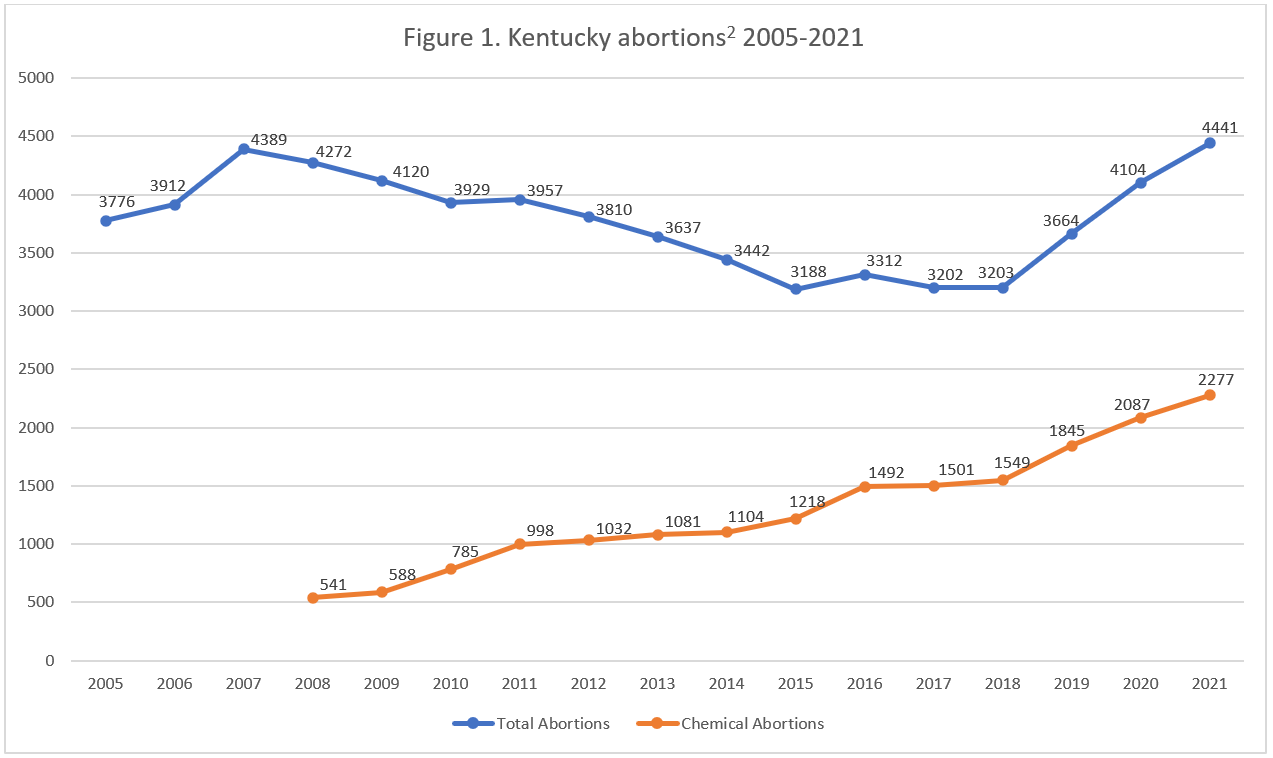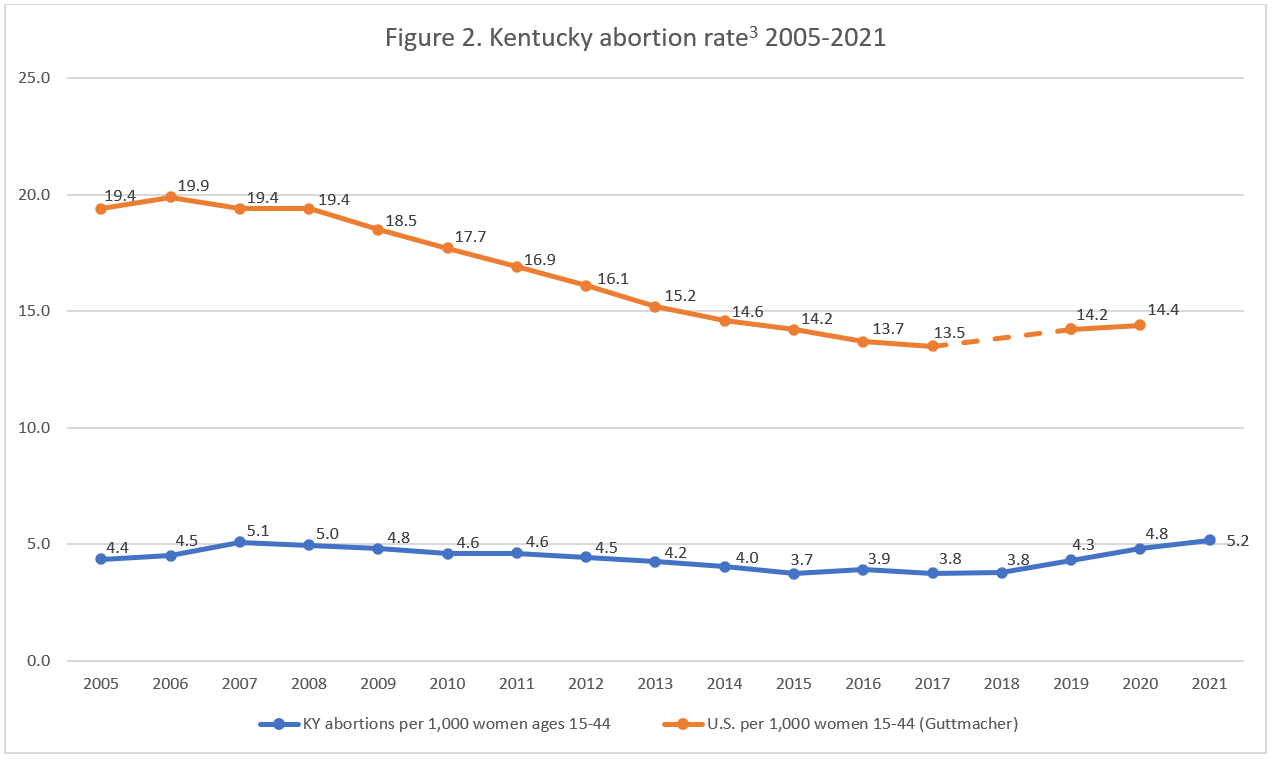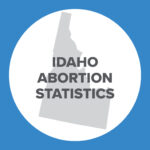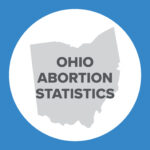Abortion Reporting: Kentucky (2021)
Kentucky’s 2021 abortion report was published by the Kentucky Cabinet for Health and Human Services in October 2022.
Statistics and Changes in Kentucky Abortions, 2020-2021

Abortion Totals and Trends
There were 4,441 abortions reported in Kentucky in 2021, an 8.2 percent increase from the previous year (Fig. 1). Chemical abortions rose 9.1 percent, composing just over half (51 percent) of the total in 2021. The Charlotte Lozier Institute (CLI) estimates that Kentucky’s abortion rate was 5.2 abortions per 1,000 women of childbearing age. This rate is much lower than the national rate but is up by eight percent from the state’s rate in 2020 (Fig. 2). As of November 2022, 24 states have released 2021 abortion statistics, of which 17 showed that abortions increased from the previous year.
State Report Summary
In 2021, 85 percent of the abortions reported in Kentucky were on state residents, and 15 percent were on residents of other states. The largest percentages of out-of-state residents who obtained abortions in Kentucky were Indiana residents (441 abortions), Tennessee residents (115), and Ohio residents (53). The percentages of Kentucky abortions performed on state residents and nonresidents remained the same as the previous year’s percentages.
Eight percent of Kentucky abortions were obtained by girls ages 19 and younger. Thirty-two percent were obtained by women ages 20 to 24, and 29 percent were performed on women ages 25 to 29. An additional 28 percent of the abortions were conducted on women in their thirties, while three percent were obtained by women ages 40 and older.
Fifty-two percent of the abortions were obtained by white women, while 34 percent were obtained by black women. Twenty-two abortions (0.5 percent) were obtained by American Indian women, and 12 percent of the abortions were on women of other races. Race was not reported for 25 abortions. Ninety-one percent of Kentucky abortions were on non-Hispanic women, and eight percent were on Hispanic women. Ethnicity was not reported for 17 abortions. CLI estimates that Kentucky’s black abortion rate was 18.6 abortions per 1,000 women ages 15 to 44, almost six times higher than the white abortion rate of 3.2 abortions per 1,000 women ages 15 to 44.
Forty-nine percent of the abortions were obtained by women with 12 years of education or fewer, while 46 percent were on women who had completed one to four years of college. Five percent, or 231 abortions, were performed on women who had finished five or more years of college, a slight increase from 2020 of 228 abortions on women with five or more years of college completed. Eighty-seven percent of Kentucky abortions were performed on unmarried women, compared to 13 percent on married women.
Thirty-four percent of the abortions reported in Kentucky were obtained by women with no previous live births. Twenty-seven percent were on women with one prior live birth, and 39 percent were on women with two or more live births. Sixty-four percent were obtained by women who reported no previous abortions, 23 percent were on women with one prior abortion, and 13 percent were on women with more than one previous abortion. Twenty-two percent of Kentucky abortions were performed on women who had previously had a miscarriage.
Just over half the abortions reported in Kentucky in 2021 – 52 percent – were chemical abortions. One of these was an abortion induced after 20 weeks, and one abortion was reported as “Other/Abortion Drug,” and the person filling out the abortion reporting form specified that the drugs used were mifepristone and misoprostol. Just under 49 percent of the abortions performed in Kentucky were surgical, with 43 percent performed via the suction curettage method and five percent conducted via the dilation and evacuation method.
Four percent of Kentucky abortions were obtained at five weeks of gestation or earlier, increasing to 26 percent at six weeks. Thirty-six percent of Kentucky abortions were performed between seven and eight weeks of gestation, and 14 percent were reported between nine and 10 weeks gestation. Nine percent occurred between 11 and 12 weeks of gestation, five percent between 13 and 15 weeks, and four percent between 16 and 19 weeks. There were 37 abortions at 20 weeks of gestation and 26 abortions at 21 weeks of gestation or later.
During the time this report covers, Kentucky limited abortion at 20 weeks post-fertilization unless the mother’s life or a major bodily function was at risk. In 2021, one abortion was reported after 20 weeks post-fertilization. The physician certified that the abortion was medically necessary, and that the abortion procedure chosen gave the unborn baby the best chance of survival; the abortion was performed using a non-surgical method. The report does not indicate whether the baby survived or not.
Kentucky’s 2021 abortion report was the second to include information on abortion complications from abortions performed in the state.1 More than one complication could be reported for each abortion. In 2021, 12 abortions were reported to have resulted in complications. There were seven incomplete abortions and two failed abortions. There was one case of cervical laceration, one of heavy bleeding that caused symptoms of hypovolemia/need for a blood transfusion, and one uterine laceration.
The overwhelming majority of Kentucky abortions, 86 percent, were performed at EMW Women’s Surgical Center in Louisville. Fourteen percent were performed by Planned Parenthood, an increase of 70 percent from the previous year. Seven abortions were reported by the University of Louisville, two by the Norton Women’s and Children’s Hospital, and one each was reported by Norton Hospital, Chandler Medical Center, Baptist Health of Lexington, and The Medical Center. July had the highest abortion total (418 abortions) and February had the lowest (309).
Legislative Changes
In 2019, the Kentucky legislature passed a trigger law that would prohibit abortion in Kentucky in all cases except if the health of the mother was in danger. The law was blocked from going into effect because the United States Supreme Court’s 1973 decision in Roe v. Wade was still precedent. However, when the Supreme Court overturned Roe v. Wade in June 2022, the trigger law went into effect as well as a fetal heartbeat law that the legislature had also previously enacted. In response to this change, Kentucky’s two abortion centers in Louisville sued the state. A month later in July 2022, a circuit judge placed a temporary injunction on both the trigger law and the fetal heartbeat law while the courts were deciding if the two laws violated Kentucky’s state constitution. In August the Kentucky Supreme Court lifted the temporary injunction and let the pro-life laws remain in effect while the Court reviews the arguments made by the two remaining abortion facilities.
State Ranking
In a 2016 CLI report evaluating abortion reporting across the country, Kentucky was ranked 43rd. Since this ranking, Kentucky has made improvements to their abortion reporting requirements and now requires abortion providers to report complications. The state’s annual abortion reports are now made available to the public online. Kentucky could continue to make improvements by requiring all health care providers, including emergency room providers, to report abortion complications they treat. Furthermore, the state could require that abortion facilities provide women’s reasons for abortions, as some states do, and ensure that the grounds for any exceptions to the state’s pro-life law are reported.


- Statistics on abortion complications reported here represent a minimal number of deaths and complications, as this data is collected in a non-systematic and non-verifiable way. As such, this data cannot be used to calculate either an accurate abortion mortality rate or an accurate abortion complication rate for the state.
- Kentucky published reports for 2017 through 2019 online and provided CLI with reports for 2015 through 2018. Abortion totals for 2005 through 2014 were taken from the annual abortion surveillance reports published by CDC. Kentucky first reported chemical abortion data to CDC in 2008.
- Rates were calculated by CLI using the following formula: (total number of abortions performed in Kentucky ÷ number of resident women ages 15-44) x 1,000. Rates may differ slightly from previous CLI articles due to revised population estimates. Population estimates were obtained from the CDC WONDER database. Estimates for 2005-2009 are intercensal estimates of the July 1 resident population. Estimates for 2010-2019 are Vintage 2020 postcensal estimates of the July 1 resident population. Estimates for 2020-2021 are Vintage 2021 postcensal estimates of the July 1 resident population. Estimates were produced by the U.S. Census Bureau and the National Center for Health Statistics.



























